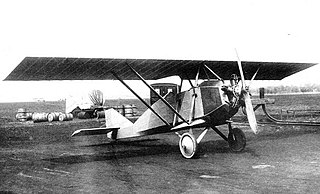Related Research Articles

The Polikarpov I-3 was a Soviet fighter designed during the late 1920s. It entered service in 1929, but was retired in 1935 with the advent of fighters with higher performance.

The Polikarpov I-6 was a Soviet biplane fighter prototype of the late 1920s. It was designed with traditional wooden construction in comparison with the wood and steel tube construction Polikarpov I-5. Its development took longer than planned and the lead designer, Nikolai Polikarpov, was arrested for industrial sabotage, which only further delayed the project. Only two prototypes were built, as the I-5 was selected for production.
The Nikitin NV-2 was a single-seat sporting aircraft produced in the USSR from 1935.
The Nikitin-Schyevchyenko IS series,, were single seat polymorphic fighters designed and produced in the USSR from 1938.

The Siemens-Schuckert R.VII was a bomber aircraft built in Germany during World War I. It was one of six aircraft based on the Siemens-Schuckert R.I that were originally intended to be identical, but which each developed in a different direction and were designated as different aircraft types by the German Inspectorate of Flying Troops.

The Polikarpov NB was a Soviet twin-engined bomber designed during World War II. Only a single prototype had been built before the program was terminated upon the death of Nikolai Nikolaevich Polikarpov, the head of the aircraft's design bureau, in 1944.

The PWS 3 was a Polish sport aircraft, developed in 1927 by PWS, which remained a prototype.

The Kawanishi K-8 Transport Seaplane was a Japanese single-engined floatplane of the 1920s. Seven were built in 1926 and 1927, and were used to operate airmail services.
The Briffaud GB-10 Pou-Push was a Mignet style tandem wing single seat aircraft with a pusher configuration single engine. The sole example was built in France in the 1980s.

The LFG Roland G.I was a large prototype single-engine biplane bomber built in Germany in 1915, during World War I. It had a single engine buried in the fuselage driving pusher configuration propellers mounted on outriggers.

The LFG V 39 was a simple biplane trainer built in Germany in the mid-1920s. It took part in the Round Germany Flight in the summer of 1925.
The IIL IS-9 was a low powered, experimental pod and boom style motor glider, designed and built in Romania in the late 1950s.

The Merville D.63 was a modification of the Druine D.62 Condor with a nosewheel undercarriage, modified fin and French engine. It flew in 1962.
The Gribovsky G-15 was a single engine, side-by-side two seat touring aircraft built in USSR in the 1930s. Only one was completed.
The WNF Wn 16 was an Austrian experimental aircraft built near the start of World War II to test the properties of the then-new tricycle undercarriage arrangement.

The Dąbrowski D.1 Cykacz (Ticktock) was an unusual, small, low-powered, single-seat biplane, intended to provide wider access to flying. Though it was exceptionally aerodynamically clean, it was under-powered and had limited range. Only one was built.
The MIP Smyk, MIP from the initials of its Polish designers with Smyk meaning Brat or Kid, was an aerodynamically refined motor glider designed and built at Warsaw Technical University from 1935.
The Sablatnig C.II was a conventional C-type reconnaissance two-seater aircraft developed and built by Sablatnig in Berlin, Germany in 1918.
The Kawanishi K-10 Transport was a 1920s Japanese passenger and mail transport. Two were built, one briefly serving a route between cities in Japan, Korea and China.
The Kawanishi K-3 was a Japanese, fast, multi-purpose civil transport aircraft from the early 1920s. Despite its good performance it was eclipsed by the release of Army surplus machines and only one was built.
References
- 1 2 3 Gunston, Bill (1983). Aircraft of the Soviet Union : the encyclopaedia of Soviet aircraft since 1917. London: Osprey. p. 288. ISBN 978-0850454451.